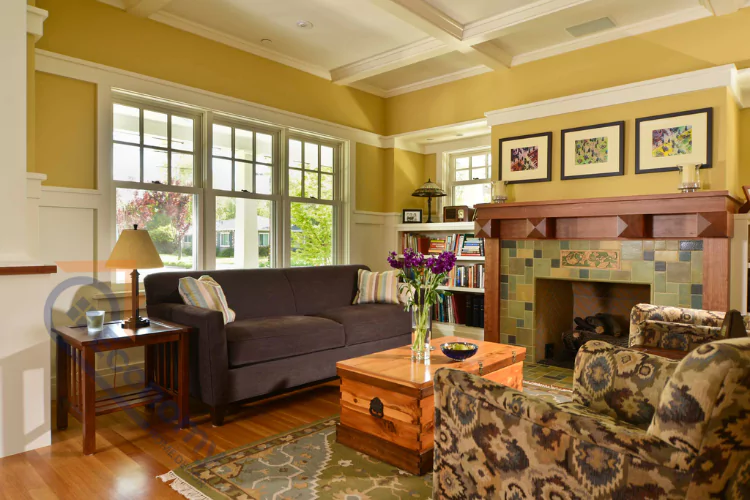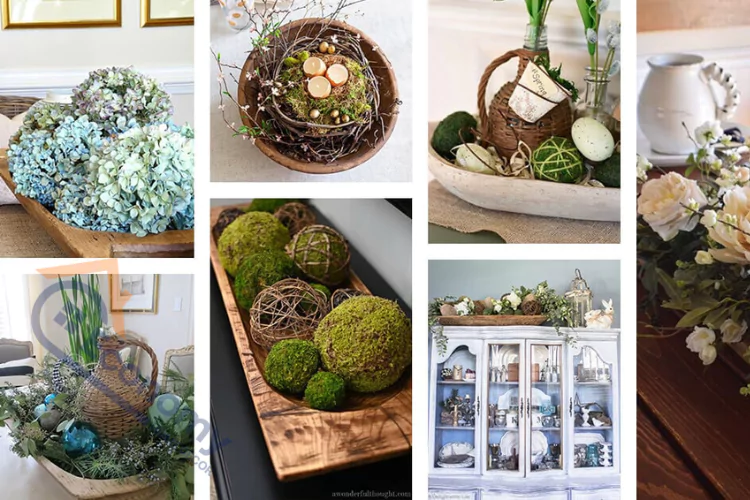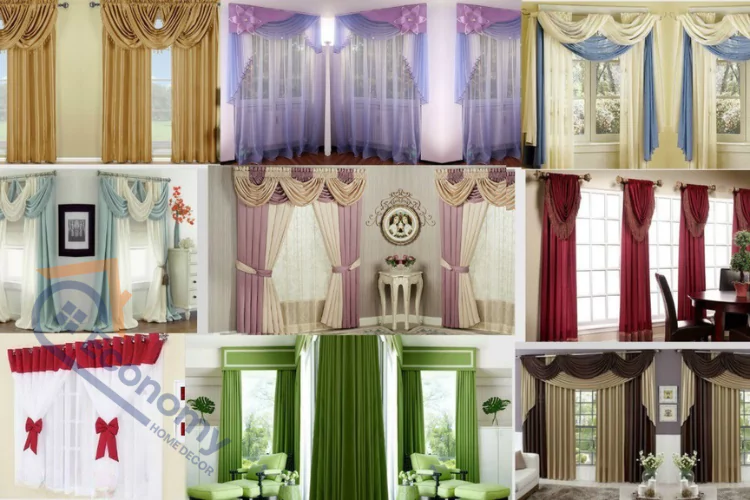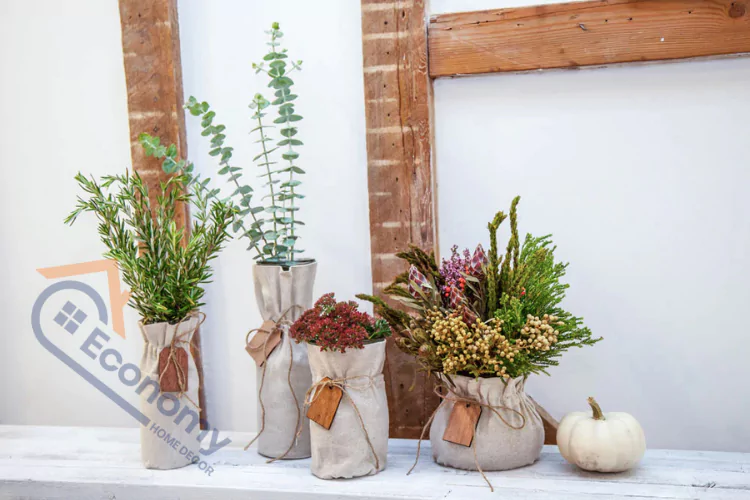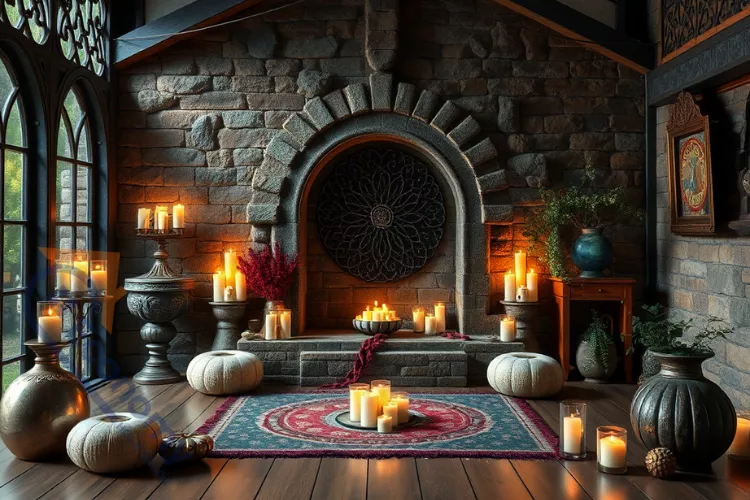The craftsman style has captured hearts and homes across America for over a century, and it’s not hard to see why. This timeless design approach celebrates quality craftsmanship, natural materials, and functional beauty that creates spaces both comfortable and sophisticated. Whether you’re living in an authentic craftsman bungalow or simply want to incorporate these beloved design elements into your modern home, craftsman decor ideas offer endless possibilities for creating warm, inviting spaces that feel both classic and contemporary.
Craftsman style decorating ideas emphasize handmade quality, built-in features, and a harmonious relationship with nature. This approach to home design originated in the early 1900s as a reaction against mass production, celebrating instead the beauty of handcrafted items and natural materials. Today’s homeowners continue to be drawn to this style because it creates spaces that feel authentic, grounded, and deeply personal.
Understanding the Core Elements of Craftsman Style
The foundation of any successful craftsman home decorating ideas implementation begins with understanding the key principles that define this beloved style. Craftsman design emphasizes horizontal lines, natural materials, and functional beauty that serves both aesthetic and practical purposes. This style celebrates the inherent beauty of wood, stone, and other natural elements while maintaining a sense of simplicity and restraint that feels both elegant and approachable.
Quality craftsmanship is perhaps the most important element of craftsman decor ideas. This means choosing furniture and accessories that show attention to detail, from dovetail joints in wooden furniture to hand-forged hardware on cabinets. The craftsman philosophy values items that are built to last, with visible construction details that become part of the overall aesthetic appeal.
The color palette in craftsman decorating typically draws from nature, featuring warm earth tones like deep browns, forest greens, and rich burgundies alongside lighter shades of cream, sage, and warm gray. These colors work together to create spaces that feel grounded and peaceful, reflecting the craftsman movement’s emphasis on harmony with the natural world.
Built-in features are hallmarks of craftsman house decorating ideas, from window seats with storage underneath to floor-to-ceiling bookcases that become architectural elements. These features maximize functionality while maintaining the clean lines that define the style.
Creating Warmth with Natural Wood Elements
Wood serves as the backbone of craftsman home decor ideas, providing both structural beauty and emotional warmth that makes spaces feel welcoming and lived-in. The craftsman style typically showcases wood in its natural state, celebrating the grain patterns and warm tones that make each piece unique. Oak, cherry, and mahogany are traditional choices, though modern interpretations might include reclaimed barn wood or sustainable bamboo options.
Exposed ceiling beams represent one of the most dramatic ways to incorporate wood into your craftsman-inspired space. These structural elements add visual weight and character while creating the sense of honest construction that defines the style. If your home doesn’t have natural beams, faux beams made from lightweight materials can provide similar visual impact without major structural changes.
Wainscoting and wood paneling offer another opportunity to introduce natural wood elements while adding architectural interest to walls. These features work particularly well in dining rooms and entryways, where they create a sense of formality and craftsmanship. The key is to choose paneling that complements rather than overwhelms the space, typically extending one-third to halfway up the wall.
Window and door trim provides opportunities for showcasing beautiful woodwork without major renovation. Wide, flat trim with simple geometric details reflects craftsman design principles while framing views to the outdoors. Consider upgrading standard trim to something more substantial, as this relatively simple change can dramatically impact a room’s overall character.
Incorporating Handcrafted Furniture Pieces
The heart of craftsman style decorating ideas lies in choosing furniture that celebrates handmade quality and functional design. Mission-style furniture, with its clean lines and visible joinery, perfectly embodies craftsman principles. These pieces feature minimal ornamentation, allowing the beauty of the wood and the skill of the craftsperson to take center stage.
Built-in seating represents the craftsman ideal of combining beauty with functionality. Window seats, breakfast nooks, and built-in benches maximize space while providing comfortable gathering spots. These features often include storage compartments, reflecting the craftsman emphasis on practical design solutions that serve multiple purposes.
Dining room furniture in the craftsman style typically features substantial proportions and visible construction details. A solid wood dining table with thick legs and a simple, sturdy design provides the perfect foundation for family gatherings. Chairs with leather or fabric seats in earth tones complement the natural wood while providing comfort for extended conversations around the table.
Living room seating should emphasize comfort and durability while maintaining the style’s characteristic simplicity. Leather sofas and chairs with simple lines and minimal decoration work well, as do fabric pieces in natural fibers like linen or cotton. The key is choosing pieces that will age gracefully and develop character over time, much like the craftsman homes they inhabit.
Mastering the Craftsman Color Palette
Color plays a crucial role in successful craftsman house decorating ideas, creating the warm, earthy atmosphere that defines this beloved style. The craftsman color palette draws inspiration from nature, featuring deep, rich hues that create a sense of groundedness and stability. These colors work together to create spaces that feel both sophisticated and comfortable, reflecting the movement’s emphasis on creating homes that nurture both body and spirit.
Earth tones form the foundation of craftsman color schemes, with deep browns, warm tans, and rich terracotta creating a base that feels connected to the natural world. These colors work particularly well on larger surfaces like walls and flooring, providing a neutral backdrop that allows furniture and accessories to shine. Forest green, deep burgundy, and navy blue serve as accent colors, adding depth and interest without overwhelming the space.
Warm gray and sage green offer lighter options that maintain the natural feeling while brightening spaces that might otherwise feel too dark. These colors work particularly well in bedrooms and bathrooms, where a lighter touch creates a more restful atmosphere. The key is choosing colors with warm undertones that complement rather than contrast with the natural wood elements throughout the home.
Color coordination between rooms creates flow and continuity that enhances the overall craftsman aesthetic. This doesn’t mean every room must be painted the same color, but rather that colors should work together harmoniously as you move through the home. Consider using different shades of the same color family or varying the intensity while maintaining the same warm undertones.
| Room Type | Primary Colors | Accent Colors | Best Use |
|---|---|---|---|
| Living Room | Deep Brown, Warm Tan | Forest Green, Burgundy | Large furniture, wall color |
| Kitchen | Sage Green, Cream | Copper, Deep Blue | Cabinets, backsplash |
| Bedroom | Warm Gray, Soft Sage | Lavender, Dusty Rose | Walls, bedding |
| Bathroom | Light Tan, Soft Green | Navy, Copper | Tile, fixtures |
| Dining Room | Rich Burgundy, Golden Brown | Deep Green, Cream | Wall color, textiles |
Lighting Design for Craftsman Spaces
Lighting design plays a pivotal role in craftsman decor ideas, creating the warm, inviting atmosphere that makes these spaces so appealing. Craftsman lighting emphasizes natural materials, geometric forms, and soft, diffused illumination that enhances rather than overwhelms the space. The goal is to create layers of light that serve both functional and aesthetic purposes while maintaining the style’s emphasis on handcrafted quality.
Mission-style pendant lights offer perfect examples of craftsman lighting principles, featuring clean geometric lines and natural materials like wood, metal, and art glass. These fixtures work particularly well over kitchen islands and dining tables, where they provide focused task lighting while serving as decorative focal points. Look for fixtures with warm metal finishes like bronze or copper that complement the natural wood elements throughout the home.
Table and floor lamps provide essential ambient lighting while offering opportunities to showcase craftsman design principles on a smaller scale. Mica or art glass shades create warm, diffused light that enhances the cozy atmosphere, while bases made from natural materials like pottery, wood, or hammered metal reflect the style’s emphasis on handcrafted quality.
Built-in lighting solutions align perfectly with craftsman philosophy, providing illumination that appears integral to the architecture rather than added as an afterthought. Under-cabinet lighting in kitchens, built-in bookcase lighting, and cove lighting in living areas all serve functional purposes while maintaining the clean lines that define craftsman design.
Textile and Fabric Choices for Authentic Appeal
The right textiles can make or break your craftsman home decor ideas, providing opportunities to introduce color, pattern, and texture while maintaining the style’s emphasis on natural materials and handcrafted quality. Craftsman textiles typically feature natural fibers, geometric patterns, and colors that complement the overall earth-tone palette. These elements work together to create spaces that feel both comfortable and sophisticated.
Natural fiber fabrics like linen, cotton, and wool provide the foundation for craftsman textile choices. These materials age beautifully and develop character over time, much like the homes they decorate. Linen curtains in natural or sage green provide privacy while maintaining connection to the outdoors, while wool rugs in geometric patterns add warmth and define seating areas.
Arts and Crafts movement patterns, including stylized florals and geometric designs, work particularly well in craftsman spaces. These patterns reflect the movement’s emphasis on nature and handcrafted design while adding visual interest without overwhelming the space. Look for fabrics that feature these patterns in the warm, muted colors that define craftsman style.
Window treatments should emphasize natural materials and simple construction that complements rather than competes with architectural details. Roman shades in natural linen, simple cotton panels, or wooden blinds all work well with craftsman decor ideas. The key is choosing treatments that provide privacy and light control while maintaining the clean lines and natural materials that define the style.
Accessorizing with Arts and Crafts Elements
Accessories provide the finishing touches that transform a house into a home, and craftsman style decorating ideas emphasize pieces that reflect the movement’s values of handcrafted quality and natural beauty. The key to successful craftsman accessorizing lies in choosing fewer, higher-quality pieces rather than filling spaces with numerous smaller items. Each accessory should serve a purpose while contributing to the overall aesthetic harmony of the space.
Pottery and ceramics offer perfect opportunities to introduce handcrafted elements that align with craftsman principles. Arts and Crafts pottery, with its characteristic glazes and simple forms, provides both functional and decorative value. Look for pieces in earth tones that complement your color palette, from large floor vases that make dramatic statements to smaller bowls and vessels that add intimate touches to shelves and tables.
Metalwork accessories, including copper bowls, wrought iron candlesticks, and hammered metal picture frames, introduce texture and visual interest while maintaining the handcrafted aesthetic. These pieces often show the marks of their making, celebrating the human touch that defines craftsman style. Mixed metals can work well together as long as they share similar warm tones and handcrafted qualities.
Books and collections displayed on built-in shelving provide both decorative value and insight into the inhabitants’ interests and personalities. The craftsman style emphasizes the importance of books and learning, making well-chosen volumes an essential part of the overall design scheme. Group books by color or subject, interspersing them with carefully chosen decorative objects for visual balance.
Creating Cozy Outdoor Spaces
Craftsman house decorating ideas extend naturally to outdoor spaces, creating seamless transitions between interior and exterior living areas. The craftsman philosophy emphasizes harmony with nature, making outdoor spaces essential components of the overall design scheme. These areas provide opportunities to enjoy handcrafted furniture and natural materials while connecting with the natural world that inspired the original craftsman movement.
Covered porches and patios represent quintessential craftsman outdoor spaces, providing shelter while maintaining connection to the outdoors. These areas benefit from the same design principles as interior spaces, featuring natural materials, comfortable seating, and careful attention to craftsmanship details. Exposed ceiling beams, stone or brick columns, and built-in seating all contribute to the authentic craftsman aesthetic.
Outdoor furniture should emphasize durability and comfort while reflecting craftsman design principles. Teak benches with simple lines, Adirondack chairs in natural finishes, and wrought iron pieces with geometric details all work well in craftsman outdoor spaces. The key is choosing pieces that will weather gracefully while maintaining their structural integrity and visual appeal.
Garden design complements craftsman architecture through the use of native plants, natural stone pathways, and simple geometric layouts. Kitchen gardens and herb plots reflect the craftsman emphasis on self-sufficiency and connection to the land. Pergolas and arbors provide structure for climbing plants while creating intimate outdoor rooms that extend the home’s living space.
Storage Solutions That Blend Function and Beauty
Built-in storage represents one of the most important aspects of craftsman home decorating ideas, reflecting the movement’s emphasis on functional beauty and space efficiency. These solutions eliminate clutter while maintaining the clean lines and natural materials that define craftsman style. The goal is to create storage that appears integral to the architecture rather than added as an afterthought.
Window seats with storage provide perfect examples of craftsman storage philosophy, combining comfortable seating with practical storage space. These built-ins work particularly well in bedrooms and living areas, where they create cozy reading nooks while housing books, linens, or seasonal items. The key is designing these features with the same attention to detail and material quality as other architectural elements.
Built-in bookcases and display shelving serve dual purposes, providing storage while creating opportunities to showcase collections and treasured objects. These features work particularly well when designed to complement existing architectural details like crown molding and baseboards. Consider incorporating different shelf heights and depths to accommodate various objects while maintaining visual interest.
Mudrooms and entryways benefit from built-in storage solutions that handle the practical needs of daily life while maintaining craftsman aesthetic principles. Built-in benches with coat hooks above and shoe storage below provide functional solutions that keep these high-traffic areas organized and welcoming. Natural materials and simple construction details ensure these spaces feel intentional rather than merely utilitarian.
Kitchen Design in Craftsman Style
The kitchen serves as the heart of craftsman home decor ideas, combining functional necessity with the style’s emphasis on quality materials and honest construction. Craftsman kitchens feature natural wood cabinets, stone or tile surfaces, and carefully chosen hardware that reflects the handcrafted aesthetic. These spaces prioritize functionality while maintaining the warm, welcoming atmosphere that defines craftsman design.
Shaker-style cabinets align perfectly with craftsman principles, featuring clean lines and minimal ornamentation that allows the beauty of natural wood to take center stage. These cabinets work particularly well in oak, cherry, or other hardwoods that develop character over time. Hardware should reflect the handcrafted aesthetic, with options like hammered copper pulls or wrought iron handles that show the marks of their making.
Natural stone countertops provide both beauty and functionality while connecting kitchen design to craftsman principles. Granite, soapstone, and butcher block all work well with craftsman decor ideas, offering surfaces that age gracefully while providing practical workspace. The key is choosing materials that complement rather than compete with cabinet finishes and overall color schemes.
Backsplash design provides opportunities to introduce pattern and texture while maintaining the natural material emphasis. Subway tile in earth tones, natural stone mosaics, or even copper tiles can work well depending on the overall design scheme. The goal is creating surfaces that provide practical protection while contributing to the overall aesthetic harmony of the space.
Bedroom Retreats with Craftsman Character
Bedrooms designed with craftsman style decorating ideas create peaceful retreats that emphasize comfort, natural materials, and thoughtful design. These spaces provide opportunities to showcase handcrafted furniture while creating environments that promote rest and relaxation. The craftsman bedroom balances simplicity with warmth, avoiding unnecessary ornamentation while maintaining visual interest through material choices and careful proportions.
Mission-style bedroom furniture provides the foundation for authentic craftsman bedrooms, featuring solid wood construction and simple, geometric lines. Platform beds with built-in nightstands maximize space efficiency while maintaining the clean aesthetic that defines the style. Dressers and armoires should complement bed design while providing necessary storage without overwhelming the space.
Natural fiber bedding in earth tones creates comfortable sleeping environments while supporting the craftsman emphasis on natural materials. Linen sheets, wool blankets, and cotton quilts all work well with this design approach. Layer different textures and tones within the craftsman color palette to create visual interest without breaking from the overall aesthetic harmony.
Built-in storage solutions work particularly well in craftsman bedrooms, where space efficiency and clean lines create restful environments. Window seats with storage, built-in wardrobes, and platform beds with integrated drawers all provide practical solutions while maintaining architectural integrity. These features should complement existing architectural details while providing necessary functionality.
Mountain Home Decorating Ideas for Craftsman Style
Mountain home decorating ideas naturally align with craftsman principles, emphasizing connection to nature, use of natural materials, and appreciation for handcrafted quality. These settings provide perfect opportunities to showcase craftsman design philosophy while addressing the unique challenges and opportunities of mountain living. The goal is creating spaces that feel both sophisticated and appropriately rustic, celebrating their natural surroundings while providing comfortable modern living.
Stone and timber construction provides the foundation for mountain craftsman homes, utilizing local materials that connect buildings to their natural settings. These materials require careful selection and skilled craftsmanship to achieve the refined rustic aesthetic that defines mountain craftsman style. Exposed stone walls, timber frame construction, and natural wood siding all contribute to this authentic mountain character.
Interior design for mountain craftsman homes emphasizes comfort and durability while maintaining connection to outdoor environments. Furniture should be substantial enough to complement the architecture while comfortable enough for extended relaxation. Leather seating, wool textiles, and substantial wooden tables all work well in these settings, providing both comfort and visual weight appropriate to mountain environments.
Color palettes for mountain craftsman homes often incorporate slightly cooler tones than traditional craftsman schemes, reflecting the natural colors of mountain environments. Deep forest greens, stone grays, and warm browns create base colors that connect interiors to exterior landscapes. Accent colors might include deeper blues and burgundies that reflect mountain skies and seasonal foliage changes.
Key Takeaways for Implementing Craftsman Decor
Successfully implementing craftsman decor ideas requires understanding and commitment to the underlying principles that define this enduring style. The craftsman approach prioritizes quality over quantity, natural materials over synthetic alternatives, and functional beauty over mere decoration. These principles guide every design decision, from major architectural features to the smallest accessory choices.
Essential Elements to Remember:
- Natural materials form the foundation of authentic craftsman design
- Handcrafted quality should be evident in furniture and accessory choices
- Earth-tone color palettes create the warm, grounded atmosphere that defines the style
- Built-in features maximize functionality while maintaining clean architectural lines
- Lighting should emphasize natural materials and provide warm, diffused illumination
- Storage solutions should blend seamlessly with architectural details
- Outdoor spaces extend craftsman principles to exterior living areas
The key to successful craftsman home decor ideas lies in patience and careful selection. This style rewards those who take time to find quality pieces that will age gracefully and develop character over time. Rather than rushing to complete rooms, focus on gradually building collections of meaningful objects that reflect craftsman values and personal taste.
Investment in quality proves particularly important with craftsman decorating, as this style emphasizes pieces that will last for generations. While initial costs may be higher, the long-term value of well-made furniture and carefully chosen materials makes this approach both economically and aesthetically sound.
Frequently Asked Questions
What makes furniture truly “craftsman style”?
Craftsman furniture emphasizes visible joinery, natural wood finishes, and simple geometric lines without excessive ornamentation. Look for pieces that show the hand of the maker through details like dovetail joints, mortise and tenon construction, and natural wood grain patterns.
Can I mix craftsman style with other design approaches?
Yes, craftsman elements work particularly well with transitional and contemporary styles that share similar values of quality construction and natural materials. The key is maintaining consistency in material choices and color palettes while allowing different styles to complement rather than compete with each other.
How do I incorporate craftsman style in a modern home?
Focus on adding natural wood elements, earth-tone colors, and handcrafted accessories to existing spaces. Built-in storage, mission-style lighting, and natural fiber textiles can all introduce craftsman character without major architectural changes.
What’s the difference between craftsman and mission style?
Mission style refers specifically to furniture design that emerged from the Arts and Crafts movement, while craftsman style encompasses the broader architectural and decorating approach. Mission furniture is one component of overall craftsman design philosophy.
Are craftsman homes energy efficient?
Traditional craftsman homes can be updated with modern energy-efficient features while maintaining their character. Focus on improving insulation, upgrading windows, and adding efficient heating systems that respect the home’s architectural integrity.
Conclusion
Craftsman decor ideas offer timeless appeal that continues to resonate with today’s homeowners who value quality, authenticity, and connection to nature. This enduring style creates spaces that feel both sophisticated and comfortable, reflecting a design philosophy that prioritizes function alongside beauty. Whether you’re working with an authentic craftsman home or incorporating these beloved elements into a modern space, the principles of natural materials, handcrafted quality, and thoughtful design will create environments that nurture both body and spirit.
The beauty of craftsman style decorating ideas lies in their flexibility and enduring relevance. These principles adapt well to contemporary living while maintaining the authentic character that makes craftsman homes so beloved. By focusing on quality materials, thoughtful craftsmanship, and connection to nature, you can create spaces that honor this important design tradition while serving the needs of modern life.
Remember that successful craftsman house decorating ideas develop over time, growing and evolving as you discover pieces that speak to your personal taste while honoring the style’s core principles. This patient approach to decorating creates homes with real character and lasting appeal, spaces that improve with age and provide comfort for generations to come.

